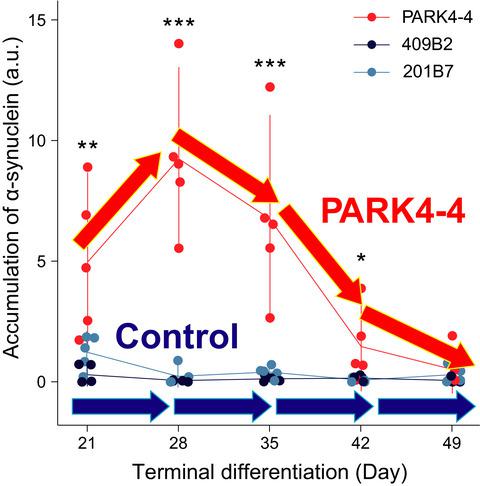当前位置:
X-MOL 学术
›
FEBS Open Bio
›
论文详情
Our official English website, www.x-mol.net, welcomes your
feedback! (Note: you will need to create a separate account there.)
Alpha‐synuclein dynamics in induced pluripotent stem cell‐derived dopaminergic neurons from a Parkinson’s disease patient (PARK4) with SNCA triplication
FEBS Open Bio ( IF 2.8 ) Pub Date : 2020-12-10 , DOI: 10.1002/2211-5463.13060 Hayato Fukusumi 1 , Kazuyuki Togo 2 , Miho Sumida 3 , Masayuki Nakamori 2 , Satoshi Obika 4 , Kousuke Baba 2 , Tomoko Shofuda 1 , Daisuke Ito 5 , Hideyuki Okano 6 , Hideki Mochizuki 2 , Yonehiro Kanemura 3, 7
FEBS Open Bio ( IF 2.8 ) Pub Date : 2020-12-10 , DOI: 10.1002/2211-5463.13060 Hayato Fukusumi 1 , Kazuyuki Togo 2 , Miho Sumida 3 , Masayuki Nakamori 2 , Satoshi Obika 4 , Kousuke Baba 2 , Tomoko Shofuda 1 , Daisuke Ito 5 , Hideyuki Okano 6 , Hideki Mochizuki 2 , Yonehiro Kanemura 3, 7
Affiliation

|
Parkinson's disease (PD) is a neurodegenerative disorder caused by the selective loss of dopaminergic (DA) neurons in the substantia nigra pars compacta (SNc). Lewy bodies (LBs), another histological hallmark of PD, are observed in patients with familial or sporadic PD. The therapeutic potential of reducing the accumulation of α‐synuclein, a major LB component, has been investigated, but it remains unknown whether the formation of LBs results in the loss of DA neurons. PARK4 patients exhibit multiplication of the α‐synuclein gene (SNCA) without any pathological mutations, but their symptoms develop relatively early. Therefore, study of PARK4 might help elucidate the mechanism of α‐synuclein aggregation. In this study, we investigated the dynamics of α‐synuclein during the early stage of immature DA neurons, which were differentiated from human‐induced pluripotent stem cells (hiPSCs) derived from either a PARK4 patient with SNCA triplication or a healthy donor. We observed increased α‐synuclein accumulation in PARK4 hiPSC‐derived DA neurons relative to those derived from healthy donor hiPSCs. Interestingly, α‐synuclein accumulation disappeared over time in the PARK4 patient‐derived DA neurons. Moreover, an SNCA‐specific antisense oligonucleotide could reduce α‐synuclein levels during the accumulation stage. These observations may help reveal the mechanisms that regulate α‐synuclein levels, which may consequently be useful in the development of new therapies for patients with sporadic or familial PD.
中文翻译:

来自 SNCA 三倍体的帕金森病患者 (PARK4) 诱导的多能干细胞衍生的多巴胺能神经元中的 α-突触核蛋白动力学
帕金森病 (PD) 是一种由黑质致密部 (SNc) 中的多巴胺能 (DA) 神经元选择性丧失引起的神经退行性疾病。路易体 (LBs) 是 PD 的另一个组织学标志,在家族性或散发性 PD 患者中观察到。已经研究了减少主要 LB 成分 α-突触核蛋白积累的治疗潜力,但尚不清楚 LBs 的形成是否会导致 DA 神经元的损失。PARK4患者表现出α-突触核蛋白基因(SNCA)的增殖,没有任何病理突变,但他们的症状发展相对较早。因此,对PARK4的研究可能有助于阐明α-突触核蛋白聚集的机制。在这项研究中,我们研究了未成熟 DA 神经元早期 α-突触核蛋白的动力学,这些神经元与源自SNCA三倍体的PARK4患者或健康供体的人诱导多能干细胞 (hiPSC) 分化。我们观察到PARK4 hiPSC衍生的 DA 神经元中的 α-突触核蛋白积累增加,相对于健康供体 hiPSC 衍生的神经元。有趣的是,在PARK4患者来源的 DA 神经元中,α-突触核蛋白的积累会随着时间的推移而消失。此外,SNCA特异性反义寡核苷酸可在积累阶段降低 α-突触核蛋白水平。这些观察结果可能有助于揭示调节 α-突触核蛋白水平的机制,从而有助于为散发性或家族性 PD 患者开发新疗法。
更新日期:2021-02-11
中文翻译:

来自 SNCA 三倍体的帕金森病患者 (PARK4) 诱导的多能干细胞衍生的多巴胺能神经元中的 α-突触核蛋白动力学
帕金森病 (PD) 是一种由黑质致密部 (SNc) 中的多巴胺能 (DA) 神经元选择性丧失引起的神经退行性疾病。路易体 (LBs) 是 PD 的另一个组织学标志,在家族性或散发性 PD 患者中观察到。已经研究了减少主要 LB 成分 α-突触核蛋白积累的治疗潜力,但尚不清楚 LBs 的形成是否会导致 DA 神经元的损失。PARK4患者表现出α-突触核蛋白基因(SNCA)的增殖,没有任何病理突变,但他们的症状发展相对较早。因此,对PARK4的研究可能有助于阐明α-突触核蛋白聚集的机制。在这项研究中,我们研究了未成熟 DA 神经元早期 α-突触核蛋白的动力学,这些神经元与源自SNCA三倍体的PARK4患者或健康供体的人诱导多能干细胞 (hiPSC) 分化。我们观察到PARK4 hiPSC衍生的 DA 神经元中的 α-突触核蛋白积累增加,相对于健康供体 hiPSC 衍生的神经元。有趣的是,在PARK4患者来源的 DA 神经元中,α-突触核蛋白的积累会随着时间的推移而消失。此外,SNCA特异性反义寡核苷酸可在积累阶段降低 α-突触核蛋白水平。这些观察结果可能有助于揭示调节 α-突触核蛋白水平的机制,从而有助于为散发性或家族性 PD 患者开发新疗法。











































 京公网安备 11010802027423号
京公网安备 11010802027423号